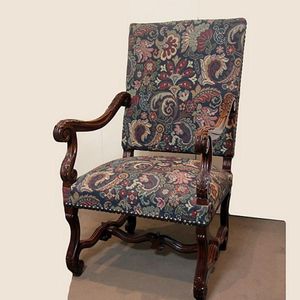Victorian Library Chair with Floral Upholstery
You must be a subscriber, and be logged in to view price and dealer details.
Subscribe Now to view actual auction price for this item
When you subscribe, you have the option of setting the currency in which to display prices to $Au, $US, $NZ or Stg.
- Mahogany - Mahogany is a dense, close grained red-coloured timber from the West Indies and Central America. It was first imported into Europe in the the early 18th century and its use continued through the 19th century. It was popular for furniture making because of its strength, the wide boards available, the distinctive grain on some boards, termed flame mahogany and the rich warm colour of the timber when it was polished.. The "flame" was produced where a limb grew out from the trunk of the tree, and this timber was usually sliced into veneers for feature panels on doors, backs and cornices.
Some terms used to describe mahogany relate to the country from which it originally came, such as "Cuban" mahogany, "Honduras" mahogany etc. However unless the wood has been tested the names assigned are more a selling feature, rather than a true indication of the timber's origin. - Turning - Any part of a piece of furniture that has been turned and shaped with chisels on a lathe. Turned sections include legs, columns, feet, finials, pedestals, stretchers, spindles etc. There have been many varieties and fashions over the centuries: baluster, melon, barley-sugar, bobbin, cotton-reel, rope-twist, and so on. Split turning implies a turned section that has been cut in half lengthwise and applied to a cabinet front as a false decorative support.
- Victorian Period - The Victorian period of furniture and decorative arts design covers the reign of Queen Victoria from 1837 to 1901. There was not one dominant style of furniture in the Victorian period. Designers used and modified many historical styles such as Gothic, Tudor, Elizabethan, English Rococo, Neoclassical and others, although use of some styles, such as English Rococo and Gothic tended to dominate the furniture manufacture of the period.
The Victorian period was preceded by the Regency and William IV periods, and followed by the Edwardian period, named for Edward VII (1841 ? 1910) who was King of the United Kingdom and the British Dominions and Emperor of India for the brief period from 1901 until his death in 1910. - Provenance - A term used to describe the provable history of an antique or work of art, and thus an additional aid to verifying its authenticity. Provenance can have an inflating effect on the price of an item, particularly if the provenance relates to the early settlement of Australia, a famous person, or royalty. Less significant are previous sales of the item through an auction house or dealer.
- Castors - Wheels, fitted especially to chair legs, couches, tables and some smaller pieces of furniture, to enable them to be easily moved about. The earliest castors were of brass, with shanks fitting into the base of the leg, and the wheels often made of leather. In the late 18th century, brass 'bucket' or 'cup' castors were introduced, either rounded or square, fitting directly over the end of the leg and held in place with screws. The wheels were generally solid brass. Bucket/cup castors continued in use throughout the 19th century and indeed are still made today. In the later 19th century wheels were sometimes made of wood, china, either white or brown, and sometimes of steel.
This item has been included into following indexes:
-
chairs, singles / pairs / threes, style or period
- desk 293
- library 293
- office 293
- Victorian, other styles 1,208
- chairs, singles / pairs / threes, timber - mahogany 1,120
Visually similar items

French Louis XIV style oak fauteuil, with a padded back and armrests on scroll supports, with a padded seat on short turned carved legs, with carved stretcher

A French walnut and floral upholstered armchair on turned legs with central stretcher

A good quality William IV period mahogany library chair, with open elbows, slightly curved back, swan neck supports to the arms, acanthus carved legs with original large brass casters - with brass studded, deep buttoned mottled olive green leather upholste

A Louis XV style bergere, with floral cloth upholstery, above out swept arms and a loose cushion, cabriole supports
